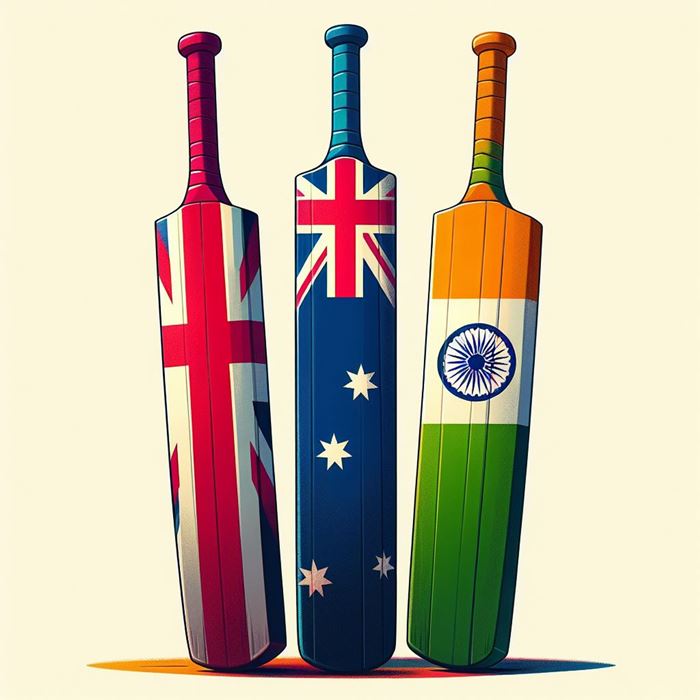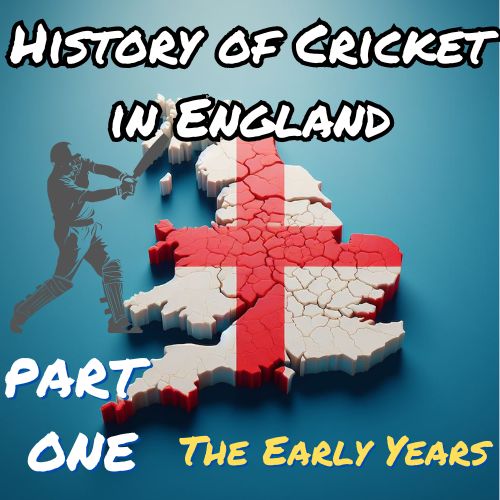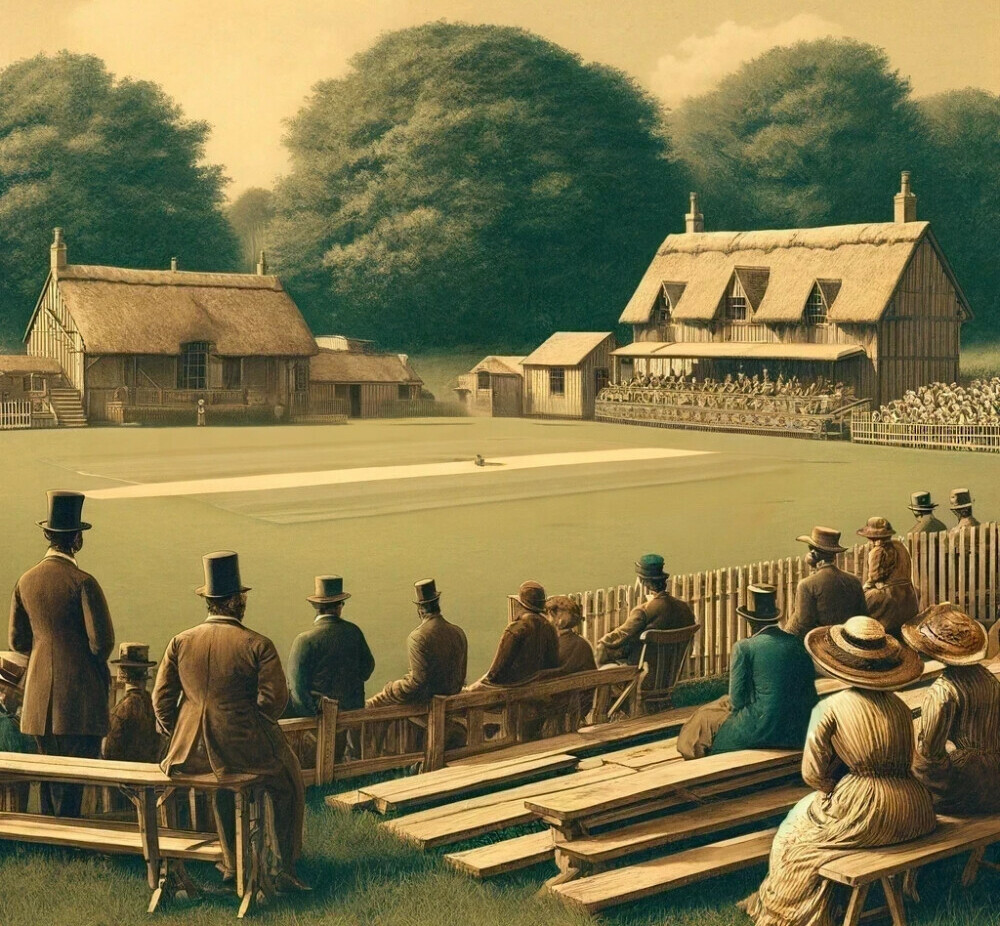Welcome to this, the first of four blog posts on the history of cricket in England. This entry will take us from the very early starting days of the sport, right up until the end of the 19th century.
Cricket is not just a sport in England. It is a historic institution that has been woven into the fabric of England’s national identity and culture. It is known as one of the oldest team sports in the country and it commands a special place in the hearts of English sports enthusiasts. Throughout England’s history, cricket has played a significant role in shaping the community and social structures of the country.
But where and when did cricket begin? That’s a hard question to answer, because cricket historians don’t agree.
But it is generally believed that the sport, or a variation of it, has been played in England since the early medieval period. Historians have noted references to cricket dating back to the end of the 16th century. At that time, it was actually a simple children’s game, but it evolved into a structured adult sport, become more and more popular among the general population, as well as the aristocracy, by the 17th century.

You can’t overstate the significance of cricket in English culture. It was more than a pastime. It represented what the English believed should be true in everyday life. It embodied values such as fair play, sportsmanship, and the balance between individual performance and team strategy.
These principles, which emerged from the village greens and fields of England, have (and still do) influence aspect of British societal norms and behaviours well beyond the boundary edge.
And even more than that, the game brought people together across different classes and backgrounds. This was particularly the case during significant matches, where the communities would gather to watch and celebrate. It was this communal aspect, this common goal between a group of people, that helped entrench cricket in the English way of life.
Cricket not only became popular, it was also a critical component of social interaction and entertainment.
As time passed, cricket evolved; its rules were formalized and it became more structured, setting the stage for the global sport it is today. This evolution reflects not only the changes of the game itself, but also the shifts in English society, highlighting the deep interconnection between the sport and the cultural fabric in England.
Early Beginnings

Guildford – now
The earliest known references to cricket dates back to a court case in 1597 relating to a plot of land in Guildford. It was known as the ‘creckett ground’ and it was used by the local schoolboys. This early reference highlights that cricket, initially a children’s past time, was already popular enough for it to merit mention in legal documents.
Back in these early days of cricket, cricket was played, predominantly by children, using rudimentary equipment; things like sticks for bats and stone or bundled rags for balls. The informal nature of these early games meant that rules were flexible and often different villages played by different rules.
But as cricket gained in popularity, it underwent a critical transformation. Adults began to play the sport, bringing in more structure and rules. This evolution was influenced by several factors, including the increasing involvement of local patrons and the establishment of gambling on the outcomes of the games.
By the 17th century, adult versions of the game began to emerge; these continued to formalize their rules and created organized teams. This period marked the beginning of cricket as a spectator sport, with matches drawing large crowds and fostering a competitive spirit.
This transformation of cricket from children’s play to an adult sport was pivotal in its development. It began to be seen not just as a form of recreation and fun, but a test of skill, strategy and physical endurance. This transition laid the foundational principles of modern cricket, such as sportsmanship and team collaboration, which were integral in elevating cricket to the prestigious and widely-followed sport it is today.
18th Century: Formalization of Cricket
During the 18th century, the sport saw the continuation of its formalization through the establishment of clubs and codification of its law. Among the foremost cricket clubs formed during this period was the Hambledon Club, established in the 1760s in Hampshire.

Monument to Hambledon Cricket Club at Broadhalfpenny Down BenShade at the English-language Wikipedia, CC BY-SA 3.0, via Wikimedia Commons
Known as the ‘Cradle of Cricket’, Hambledon played a pivotal role in transitioning cricket from a pastime into a serious sport. It was at Hambledon where many of the game’s early strategies and techniques were developed, influencing how cricket was played across England.
However, the most significant development in the formalization of cricket came with the found of the Marylebone Cricket Club (MCC) in 1787. The MCC was established in London, and soon became the guardian of cricket laws.
In 1788, the MCC took the decisive step in shaping modern cricket by codifying the Laws of Cricket. This meant that not only where the rules of cricket standardized, but regulations were laid down regarding the dimensions of the pitch, wickets and balls. This brought a uniformity to the game that had previously been played under a myriad of local variations.
The MCC’s codification of the laws helped cricket to expand beyond local playfields to national and (eventually) international levels. The establishment of standardized rules made it easier to organize matches and tournaments, enhancing the sport’s competitiveness and appeal.
As a result, cricket began to attract wider public interest and greater media coverage. This further established cricket’s prominence in the English sporting landscape.
19th Century: Expansion and Popularity
The 19th century witness cricket’s remarkable expansion and solidification as a key component of English cultural identity, a movement significantly propelled by the British Empire. As the Empire extended its reach, cricket served as a cultural export that helped to reinforce British norms and values in its colonies. This global spread played a vital role back home in England by reinforcing cricket’s status as a quintessentially British sport, deeply entwined with national pride and identity.
AI artist depiction of 19th Century English village cricket ground
Within England itself, this period saw the formal establishment of country cricket. The foundation of major clubs like Yorkshire, Lancashire and Surrey in the 1830s and beyond brought a new organizational structure to the game, emphasizing local pride and competition.
The competitive structure of county cricket also fostered significant advancements in playing standards and tactics, contributing to the professionalization of the sport.
The Birth of Test Cricket
The birth of Test Cricket, a significant milestone in the history of the sport, was marked by the first officially recognized Test match between England and Australia in March 1877.
The origins of this inaugural Test match stem from the growing popularity of cricket in both England and Australia and the desire to formalize competition between the two nations. The idea was driven by mutual interest in establishing a sporting contest that would not only test the skills of the two nations but also strengthen colonial ties with the British Empire. Cricket, having developed significantly in the 1870s in Australia, was the natural choice.

James Lillywhite [1][2], Public domain, via Wikimedia Commons
James Lillywhite, the English cricketer and sports outfitter, captained the English side and was instrumental in organizing the tour that led to the test match. His team, consisting of professional players, embarked on a journey to Australia, not just to play a series of matches against local teams but also to participate in what would become the first official recognized Test match.
Cricket was no longer just an English domestic sport, but an international competition, able to showcase the sport’s ability to bridge diverse cultures and geographies. The match also set a precedent for the future of cricket, establishing Test cricket as the sport’s highest standard.
Key figures in the historic match include Australia’s Charles Bannerman, who became the first player to score a century in Test cricket with 165 runs in the team’s first innings. This performance was instrumental in setting up Australia’s eventual 45 run victory.
This was a result that was both celebrated by the Australians and taken as a call to action by the English cricket community. It also sparked a competitive rivalry that would grow into one of the most storied in all of sports; the Ashes series, which began five years later in 1882.
England’s Early Test Matches
Following the inaugural Test match in 1877, England’s Test cricket landscape began to evolve rapidly. The team’s early matches were characterized by a mix of triumphs and challenges, as they adapted to the demands of international competition.
The significant turning point in England’s cricket history came in 1882 when Australia defeated England at The Oval. This loss on home soil was a national shock and was dramatically reported in the sporting press.
The famous obituary published in ‘The Sporting Times’ stated that English cricket had died, and ‘the body will be cremated and the ashes taken to Australia.’ This whimsical yet poignant commentary led to the creation of the Ashes series, a biennial contest between England and Australia that has become a cornerstone of international cricket.
This rivalry between England and Australia grew with each series, characterized by intense competition and extraordinary performances. Key figures such as W.G. Grace in England, and Fred Spofforth for Australia, emerged. They not only captivated audiences with their skill but all advanced the sport’s technical and tactical development.
The matches from this period were not just sporting events; they were occasions that captured the public imagination and reflected broader national sentiments. The fierce rivalry that developed served to enhance the popularity of cricket, making it a staple of English sporting culture.
England’s test results during these early years were successful by anyone’s reckoning. By the end of the 19th century, England had played 64 games, winning 34, losing 20 and drawing just 10. Most of these tests were against Australia (56) and England still sported a positive win/loss record against their fiercest rivals (26 wins, 20 loses, 10 draws).
By these results is was clear that the stage was set for England’s role in the global expansion of cricket, establishing the nation as a central figure in the sport’s international narrative.
Key Players and Personalities
The 19th century was a defining era for cricket, not least because of the towering figures who dominated the sport and left indelible marks on its history. Among these, none shone brighter than W.G. Grace, whose name became synonymous with cricket in England and beyond.

W.G. Grace 1902 George Beldam, Public domain, via Wikimedia Commons
W.G. Grace, affectionately known as “The Doctor” due to his medical qualification, was renowned for his exceptional batting skills and charismatic personality. His career, which spanned over four decades, was filled with remarkable achievements. Grace was the first player to score 100 centuries, and he accumulated more than 54,000 runs in first class cricket. His aggressive batting style and a commanding presence at the crease made the game of cricket more dynamic and entertaining to watch.
Other significant figures of the era were players like Alfred Shaw, who bowled the first ball in Test cricket, and James Lillywhite, captain of the first England Test cricket team.
Impact of Social and Economic Factors
The development of cricket in England during the 19th century was deeply intertwined with the broader social and economic transformations of the era.
The Industrial Revolution brought about significant changes in the social structure of England, leading to the rise of the middle class and the creation of more leisure time. This shift allowed more individuals to engage in recreational activities, and cricket, with its evolving club structure and county competitions, offered an appealing pastime.
Additionally, cricket’s role in British imperial identity cannot be overstated. As the British Empire expanded, cricket became a key element of colonial policy, used as a tool to promote British values and cultures in the colonies. The sport was introduced as a civilizing influence, an embodiment of fairness and moral integrity, which were seen as quintessential British qualities.

In colonies like India, Australia and the West Indies, cricket was adopted and adapted, becoming part of the local culture and a point of both colonial control and local resistance.
Cricket became a symbol of British identity, reflecting and shaping the social and political dynamics of the time. Through cricket, the British projected their image of propriety and sportsmanship, which were integral to their self-conception as rulers.
The impact of these social and economic factors on cricket’s development was profound, providing the sport with a unique cultural and political role that influenced its growth and the form it took, both within England and across the British Empire.
Challenges and Controversies
During the formative years of Test cricket in the late 19th century, the sport faced significant challenges and controversies, particularly surrounding the issues of amateurism and professionalism. These debates not only influenced the governance and organization of cricket, but also mirrored the class distinctions prevalent in society at the time.
Amateurs, known as “Gentlemen”, were typically from the upper classes and played cricket as a pastime without financial compensation. Conversely, professionals, referred to as “Players”, were generally from the working class and relied on the sport for their livelihood.
The distinction between Gentlemen and Players was manifest in various aspects of the sport. Professionals often faced less favourable conditions, such as inferior travel arrangements and changing facilities, compared to their amateur counterparts.
Controversies often arose around match fixtures and the composition of teams, with disputes about the perceived fairness in selection process and the conduct of players on the field. One notable incident involved the English team selection for tours, which was heaving criticized for favouring amateurs despite the professional players’ evident skill and contributions to the game.
Legacy and Influence on Future Generations
The early days of Test Cricket was pivotal in laying the foundation stones for modern Test cricket, with its impacts resonating far beyond the boundaries of its time. The period not only shaped the structural and organisational aspects of cricket but also established traditions and rivalries that continue to influence the game today.
The traditions, rivalries and structures established during the 19th century and even earlier have not only survived but have thrived, continually influencing the evolution of cricket. They foster a sense of continuity and community among fans and players alike, bridging generations and providing a shared heritage that enriches the sport. This enduring influence ensures that while the game may evolve with technology and time, the spirit of 19th-century cricket remains a guiding force in its modern incarnation.
I hope you have enjoyed this post about the early history of cricket in England. Please stay with us for part two, where we look at the history of cricket in England from 1900 to World War 2.


